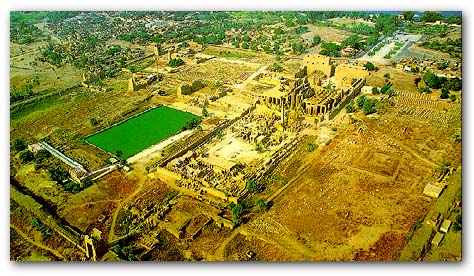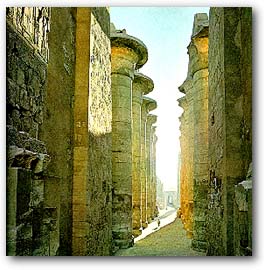Temple of Karnak

Mut, Monthu and Amun are enclosed by enormous brick walls.
The Open Air Museum is located to the north of the first courtyard, across from the Sacred
Lake. The main complex, The Temple of Amun, is situated in the center of the entire complex.
The Temple of Monthu is to the north of the Temple of Amun, while the Temple of Mut is to
the south.
The Second Pylon of Karnak was built by Ramesses II. The Ptolemies did some extensive
repairing and some new building on the center section. Curiously enough, they left the columns
and the facade of the First Pylon unfinished and left the mud-brick ramp where it was. The
reason for the work left unfinished is not clear.
 Ramesses I's reign. He was the king who founded the Nineteenth Dynasty and was king for
only one year. The work continued under Seti I (1306 - 1290 BC). Seti I also built the
Temple of Abydos and many other temples. The hall was completed by Seti's son, Ramesses
II. The effects that are produced inside the hall are much different than they were originally.
The huge architraves are not above the capitals that tower above. Towards to center of the
hall several architraves and windows that have stone latticework still remain. This small area
can give you an idea of the builders' intent for the lighting effects. Some imagination is required
here to appreciate what it must have looked like. The walls, ceilings and columns are painted
with the natural earth tones. The light that was allowed in originally kept most of the hall in
shadows. The hall ceiling was 82 feet high and was supported by 12 papyrus columns. The
columns are made of sandstone and set in two rows of six. Each row is flanked on either side
by 7 rows of columns that are 42 feet (12.8m) high. Each row has 9 columns, however the
inner rows have 7 columns. The reliefs throughout the hall contain symbolism of Creation. The
reliefs in the northern half are from the time period of Seti I and are obviously better done than
those done by his son Ramesses II, which are in the southern half. Ramesses II's reliefs are cut
much deeper than those of Seti's. This gives a much more dramatic light and shadow effect. Ramesses I's reign. He was the king who founded the Nineteenth Dynasty and was king for
only one year. The work continued under Seti I (1306 - 1290 BC). Seti I also built the
Temple of Abydos and many other temples. The hall was completed by Seti's son, Ramesses
II. The effects that are produced inside the hall are much different than they were originally.
The huge architraves are not above the capitals that tower above. Towards to center of the
hall several architraves and windows that have stone latticework still remain. This small area
can give you an idea of the builders' intent for the lighting effects. Some imagination is required
here to appreciate what it must have looked like. The walls, ceilings and columns are painted
with the natural earth tones. The light that was allowed in originally kept most of the hall in
shadows. The hall ceiling was 82 feet high and was supported by 12 papyrus columns. The
columns are made of sandstone and set in two rows of six. Each row is flanked on either side
by 7 rows of columns that are 42 feet (12.8m) high. Each row has 9 columns, however the
inner rows have 7 columns. The reliefs throughout the hall contain symbolism of Creation. The
reliefs in the northern half are from the time period of Seti I and are obviously better done than
those done by his son Ramesses II, which are in the southern half. Ramesses II's reliefs are cut
much deeper than those of Seti's. This gives a much more dramatic light and shadow effect.
The outer walls of the Hypostyle Hall are covered with scenes of battle. Again, Seti I is to the
north and Ramesses II is to the south. The scenes have long since lost their color that was
painted and the outlines of the scenes have been blurred by the centuries of wind and sun. It is
unsure whether the scenes of battle are based on historical fact or of ritual significance. It is
thought that when the battle details are very precise, real events are most likely involved. Seti's
battles take place in Lebanon, southern Palestine and Syria. The southern walls of Ramesses
II have hieroglyphic texts which actually record details of the Hittite king and Ramesses II
signing a peace treaty in the twenty-first year of Ramesses reign. This is the first evidence
found for a formal diplomatic agreement and is certainly historical.
The Transverse Hall lies beyond the rear wall of the Hypostyle Hall. The wall is mostly ruined.
With the Transverse Hall is a partially reconstructed Third Pylon of Amenhotep (Amenophis)
III. The Transverse Hall has remains of the earliest sections of the Karnak complex that are
still in existence.
Leaving the hypostyle hall through the third pylon you come to a narrow court where there
once stood several obelisks. One of the obelisks was erected by Tuthmosis I (1504 - 1492
BC) who was the father of Hatshepsut. This obelisk stands 70 feet (21.3m) tall and weighs
about 143 tons. During the centuries between Tuthmosis I and Ramesses VI, the kings of the
time did more than their share of destroying and dismantling. This obelisk was never touched.
The original inscription was left in its place. However, two kings did add their inscription on
either side of the original. Beyond this obelisk is the only remaining Obelisk of Hatshepsut
(1473-1458 BC). It is 97 feet (29.6m) high and weighs approximately 320 tons. Besides the
Lateran obelisk in Rome, this is the tallest standing obelisk. The one in Rome is 101 feet
(30.7m) high. Hatshepsut was a woman who dared to challenge the tradition of male kingship.
She died from undisclosed causes after imposing her will for a time. After her death, her name
and memory suffered attempted systematic obliteration. The inscription on the obelisk says,
"O ye people who see this monument in years to come and speak of that which I have made,
beware lest you say, 'I know not why it was done'. I did it because I wished to make a gift for
my father Amun, and to gild them with electrum." Tuthmosis III (1479-1425 BC) was
Hatshepsut's successor. When he came to power, he built a high wall around her obelisk. This
wall hid the lower two-thirds but left the upper towering above. It has been thought that this
was an easier and cheaper way of destroying her memory than actually tearing it down and
removing it. If Tuthmosis had really wanted to destroy the obelisk, he would have certainly
torn it down and removed it. Perhaps that was another reason for his building the wall. The
top of the obelisk was visible for 50 miles (80 km). The pink granite for the obelisk was
quarried at Aswan, which is several hundred miles south of Karnak. The stone was moved
several miles over to the river and shipped down to Thebes. The setting of the stone is shown
on reliefs as the pharaoh raising it with a single rope tied to its upper extremity. This is most
probably symbolic, but may have been done this way with several hundreds of people pulling
together. To the south of the standing obelisk is its companion which has fallen. It was also
make of a single block of granite but is broken now.
The Sixth Pylon, which was built by Tuthmosis III, leads into a Hall of Records in which the
king recorded his tributes. Very little remains of this archive beyond two granite pillars. Just
beyond these pillars lies the Holy of Holies or sanctuary. Originally it was the oldest part of the
temple. The present sanctuary was built by the brother of Alexander the Great, Philip
Arrhidaeus (323-316 BC) who was the King of Macedonia. The present sanctuary was built
on the site of the earlier sanctuary built by Tuthmosis III. The present sanctuary contains
blocks from the Tuthmosis sanctuary and still contain Tuthmosis' inscriptions. The sanctuary is
built in two sections. Why this was done is not known.
|





